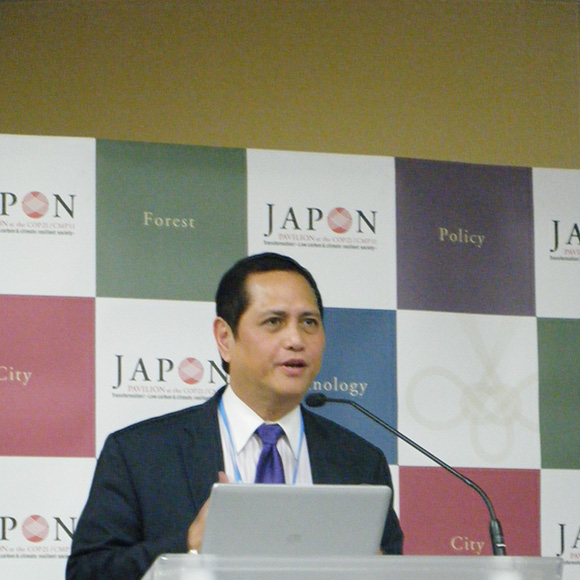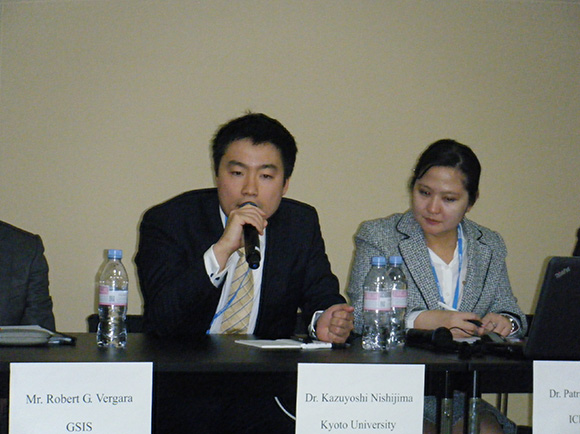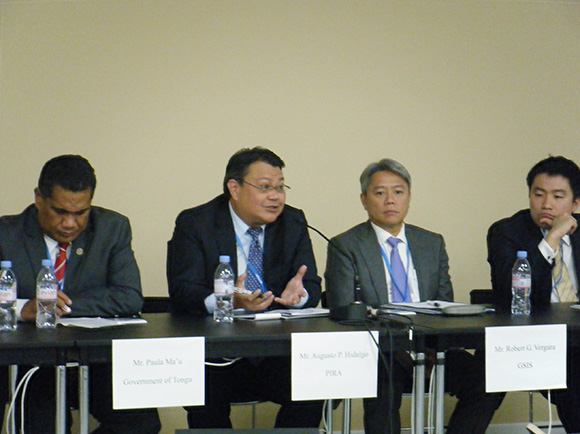Disaster Risk Finance and Insurance in Asia-Pacific Regions
Japan International Cooperation Agency (JICA); World Bank
Outline
This event presents the role, current developments and challenges as well as future perspectives on Disaster Risk Finance and Insurance initiatives in the Pacific region as well as in Asia including the Philippines. Experts from relevant governments, academe as well as private sector are invited to provide their perspectives through their presentations and panel discussions.
Program
-
- Opening & Motivation of the Seminar
- Mr. Jin Wakabayashi, Director, Southeast Asia Division 5, Southeast Asia and Pacific Department, Japan International Cooperation Agency (JICA)
Mr. John Roome, Senior Director, Climate Change, World Bank
-
- Philippines Disaster Risk Financing: Step Forward for Building Disaster Resilience in the Philippines – Emerging Strategies for Disaster Risk Reduction and Financing
- Mr. Robert B. Tan, National Treasurer, Government of the Philippines
-
- Hydro-related Risks in Asia-Pacific and the Role of Disaster Risk Finance and Insurance: Tonga Experience
- Mr. Paula P. Ma’u, Chief Executive Officer (CEO), Ministry of Meteorology, Energy, Information, Disaster Management, Environment, Climate Change and Communications (MEIDECC), the Kingdom of Tonga
Mr. Tatafu Moeaki, CEO, Ministry of Finance and National Planning, the Kingdom of Tonga
-
- Overview of Hydro-related Risks in Asia: Looking from the Lens of Science
- Dr. Patricia Ann A. Jaranilla-Sanchez, Research Specialist, International Center for Water Hazard and Risk Management (ICHARM)
-
- Decomposition of Cyclone/Typhoon Related Risk
- Dr. Kazuyoshi Nishijima, Associate Professor, Disaster Prevention Research Institute, Kyoto University
-
- Panel Discussion and Q&A
-
- [Panelists]
- Mr. Paula P. Ma’u, Chief Executive Officer, MEIDECC, the Kingdom of Tonga
Mr. Robert G. Vergara, President and General Manager, Government Service Insurance System (GSIS)
Mr. Augusto P. Hidalgo, CEO, Philippines Insurers and Reinsurers Association (PIRA)
Dr. Patricia Ann Jaranilla-Sanchez, Research Specialist, ICHARM
Dr. Kazuyoshi Nishijima, Associate Professor, Disaster Prevention Research Institute, Kyoto University
Dr. Megumi Muto, Chief Representative, JICA France Office
- [Moderator]
- Mr. James Close, Director, Climate Change, World Bank
-
- Closing
- Dr. Megumi Muto, Chief Representative, JICA France Office
Summary
Mr. Roome, World Bank
- Availability of financing for both household and country levels is critical in enhancing overall resilience of disaster-prone countries, and it is necessary to come up different financial instruments in a complementary manner to cater different needs of different levels (national, sub-national, household) for both ex-ante and ex-post investment as well as contingent financing requirements.
Mr. Tan, Government of the Philippines
- The Philippines formulated the Disaster Risk Financing and Insurance Strategy that includes financial initiatives such as standy-by facility (Cat-DDO, SECURE) supported by the World Bank and JICA at national level, the pilot of a Local Government Unit (LGU) catastrophe pool at sub-national level, and a potential residential insurance pool at household level to provide households with disaster risk coverage on earthquakes and typhoons.
Mr. Ma’u and Mr. Moeaki, Government of Tonga
- Tonga received the payout from Pacific Catastrophe Risk Assessment and Financial Initiative (PCRAFI) upon the hit by Cyclone Ian in January 2014, which was critical in financing Tonga’s immediate coordinated actions for relief. One challenge is that not all disaster-experiencing members of PCRAFI received the payout when needed due partly to difficulties in assessing the risks they face and choosing the right coverage.
Dr. Sanchez, ICHARM
- Disaster risk management need to be formulated based on the sound evidence provided by sound disaster risk assessments. Hazard and disaster data is essential to develop risk indicators for risks assessment, and sustainable data and information management with capacity development is required, where international cooperation has a role to play in creating and sustaining public knowledge and information.
Dr. Nishijima, Kyoto University
- Wind-related disaster (typhoon and cyclone) risks need to be decomposed to examine exposure and vulnerability of each structure from engineering perspective. Also important are i) mainstreaming engineering knowledge in disaster-prone countries; ii) improving existing structures in more resilient manners utilizing the local knowledge; and iii) mobilizing development partners’ financial and technical assistance to endogenous mechanism for resilience enchancement.
Mr. Vergara, GSIS
- The mandate of GSIS includes insuring all the government properties. GSIS is working with the World Bank and the Government of the Philippines on the development of cat risk assessment pooling targeting at local governments.
Mr. Hidalgo, PIRA
- PIRA works with IFC and others on development of cat risk pooling for private enterprises and households, with the combination of parametric insurance to provide a quick payout and traditional insurance against actual loss to adjust the additional payout. They also consider the possibility of introducing credit rating based on resilience indicators for structures to incentivize ex-ante investment.
Dr.Muto, JICA
- When it comes to the realization of BBB concept into practice, the key question to each country would be at what level (frequency and size of expected consequence/damage/loss) we should be prepared by how much we spend. High-frequent, low-consequence events tend to be easily foreseen and thus people are more aware of, while preparedness for low-frequent, high-consequence events requires some innovation to incentivize and finance the actions and investments to be taken by countries, their local government and households.
- Issues for further consideration include: how to design the optimal incentives in financial initiative such as insurance pool that balances both private sectors’ profits and public sectors’ financial sustainability; how to build and update the public goods in terms of disaster and exposure risk data and assessment through mobilization of research community; and what would be optimal combinations of financing instruments and public-private partnership to finance seamless activities from disaster preparedness, relief, recovery and BBB-reconstruction.
Key Messages
When it comes to the realization of BBB concept into practice, the key question to each country would be at what level (frequency and size of expected consequence/damage/loss) we should be prepared by how much we spend. High-frequent, low-consequence events tend to be easily foreseen and thus people are more aware of, while preparedness for low-frequent, high-consequence events requires some innovation to incentivize and finance the actions and investments to be taken by countries, their local government and households.
Issues for further consideration include: how to design the optimal incentives in financial initiative such as insurance pool that balances both private sectors’ profits and public sectors’ financial sustainability; how to build and update the public goods in terms of disaster and exposure risk data and assessment through mobilization of research community; and what would be optimal combinations of financing instruments and public-private partnership to finance seamless activities from disaster preparedness, relief, recovery and BBB-reconstruction.
Photograph
Reporters
Jin Wakabayashi, Director, Southeast Asia Division 5, Southeast Asia and Pacific Department, Japan International Cooperation Agency (JICA)








